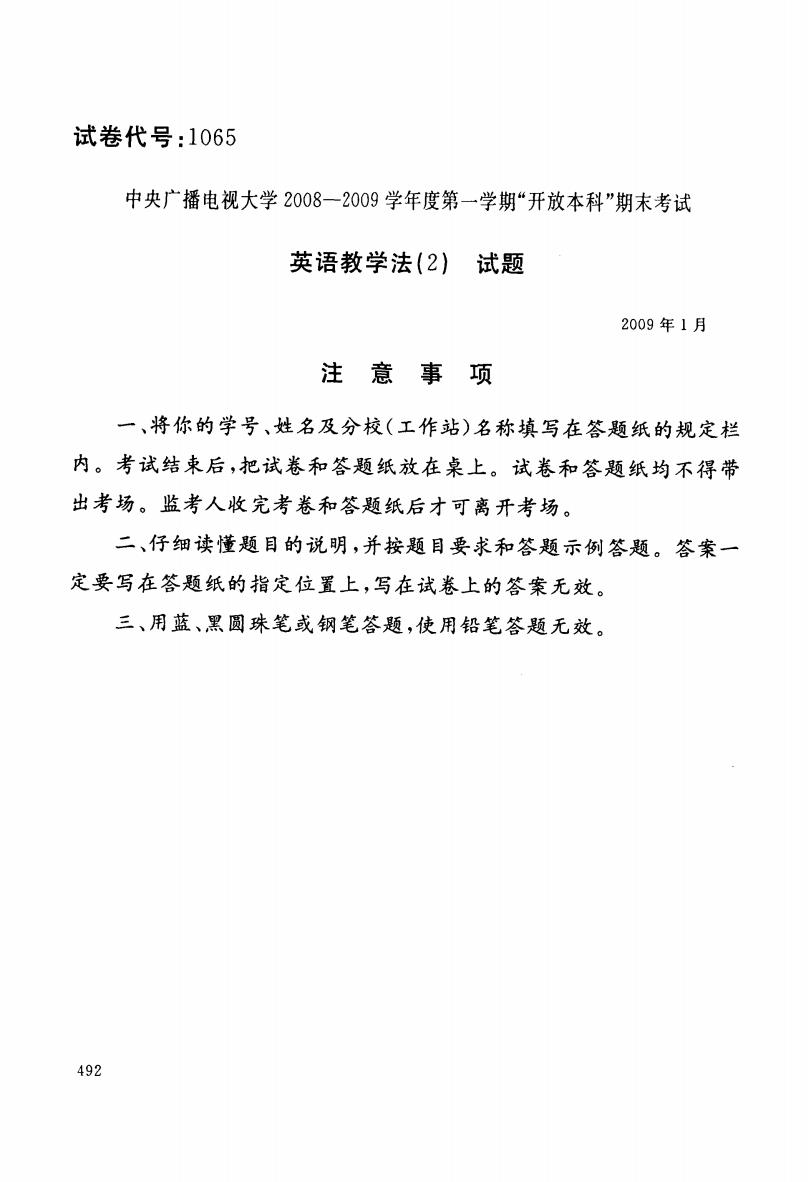
试卷代号:1065 中央广播电视大学2008一2009学年度第一学期“开放本科”期末考试 英语教学法(2)试题 2009年1月 注意事项 一、将你的学号、姓名及分校(工作站)名称填写在答题纸的规定栏 内。考试结束后,把试卷和答题纸放在桌上。试卷和答题纸均不得带 出考场。监考人收完考卷和答题纸后才可离开考场。 二、仔细读懂题目的说明,并按题目要求和答题示例答题。答案一 定要写在答题纸的指定位置上,写在试卷上的答案无效。 三、用蓝、黑圆珠笔或钢笔答题,使用铅笔答题无效。 492
试卷代号:1065 中央广播电视大学2008-2009学年度第一学期“开放本科”期末考试 英语教学法(2) 试题 2009年 1月 注 意 事 项 一、将你的学号、姓名及分校(工作站)名称填写在答题纸的规定栏 内。考试结束后,把试卷和答题纸放在桌上。试卷和答题纸均不得带 出考场。监考人收完考卷和答题纸后才可离开考场。 二、仔细读懂题 目的说明,并按题 目要求和答题示例答题。答案一 定要写在答题纸的指定位置上,写在试卷上的答案无效。 三、用蓝、黑圆珠笔或钢笔答题,使用铅笔答题无效
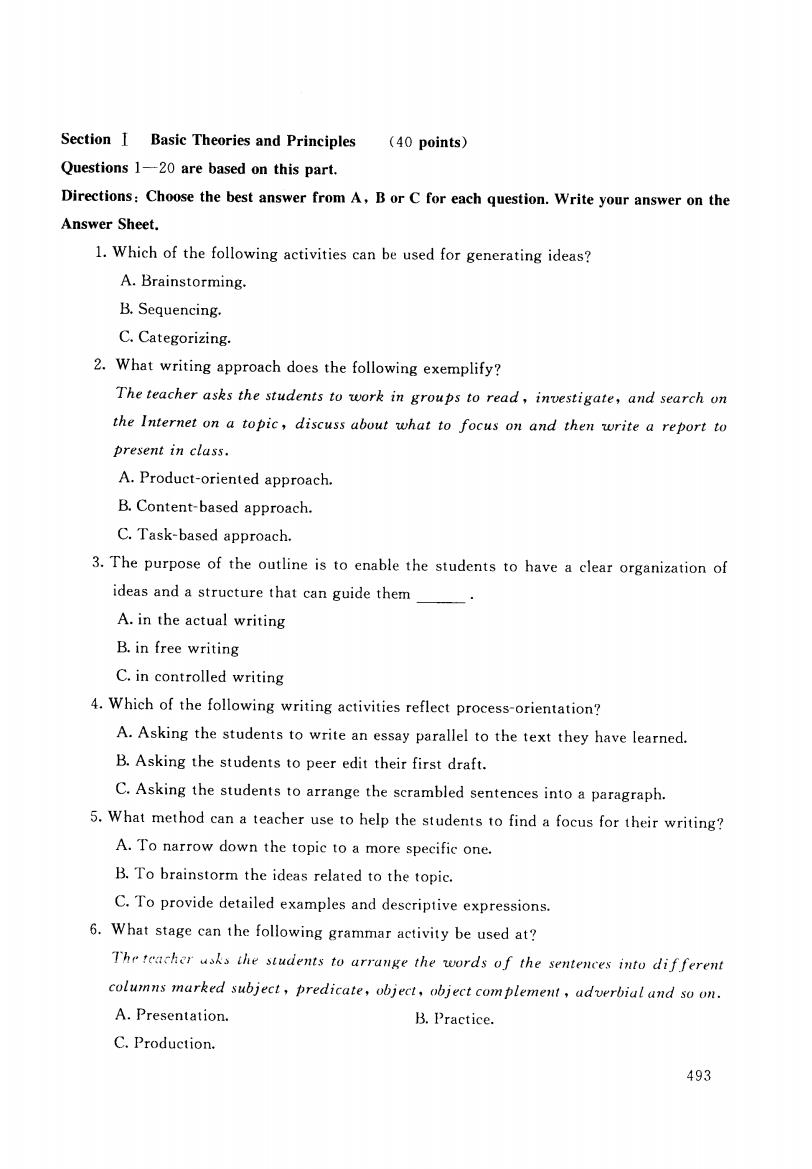
Section I Basic Theories and Principles (40 points) Questions 1-20 are based on this part. Directions:Choose the best answer from A,B or C for each question.Write your answer on the Answer Sheet. 1.Which of the following activities can be used for generating ideas? A.Brainstorming. B.Sequencing. C.Categorizing. 2.What writing approach does the following exemplify? The teacher asks the students to work in groups to read,investigate,and search on the Internet on a topic,discuss about what to focus on and then write a report to present in class. A.Product-oriented approach. B.Content-based approach. C.Task-based approach. 3.The purpose of the outline is to enable the students to have a clear organization of ideas and a structure that can guide them A.in the actual writing B.in free writing C.in controlled writing 4.Which of the following writing activities reflect process-orientation? A.Asking the students to write an essay parallel to the text they have learned. B.Asking the students to peer edit their first draft. C.Asking the students to arrange the scrambled sentences into a paragraph. 5.What method can a teacher use to help the students to find a focus for their writing? A.To narrow down the topic to a more specific one. B.To brainstorm the ideas related to the topic. C.To provide detailed examples and descriptive expressions. 6.What stage can the following grammar activity be used at? The teacher usks the students to arrange the words of the sentences into different columnns marked subject,predicate,object,object complement,udverbial and so on. A.Presentation. B.Practice. C.Production. 493
Section j Basic Theories and Principles Questions 1一20 are based on this part. Directions:Choose the best answer from A, Answer Sheet, 1. Which of the following activities can (40 points) 址 on t’J B or C for each question. Write your answer on be used for generating ideas? A. Brainstorming. B. Sequencing. C. Categorizing. 2. What writing approach does the following exemplify? The teacher asks the students to work in groups to read,investigate, and search the Internet on a topic,discuss about what to focus on and then write a report present in class. A. Product-oriented approach. B. Content-based approach. C. Task-based approach. 3. The purpose of the outline is to enable the students to have a clear organization of ideas and a structure that can guide them_ . A. in the actual writing B. in free writing C. in controlled writing 4. Which of the following writing activities reflect process-orientation? A. Asking the students to write an essay parallel to the text they have learned. B. Asking the students to peer edit their first draft. C. Asking the students to arrange the scrambled sentences into a paragraph. 5. What method can a teacher use to help the students to find a focus for their writing? A. To narrow down the topic to a more specific one. B. Tobrainstorm the ideas related to the topic. C. Toprovide detailed examples and descriptive expressions. 6. What stage can the following grammar activity be used at? Th (' ! r, "ch C,一“。, &'.): Ihe students to arrange the words of the sentences into different columns marked subject,predicate, object,object complement,adverbial and so〔,,,. A. Presentation. 13. Practice. C. Production. 493
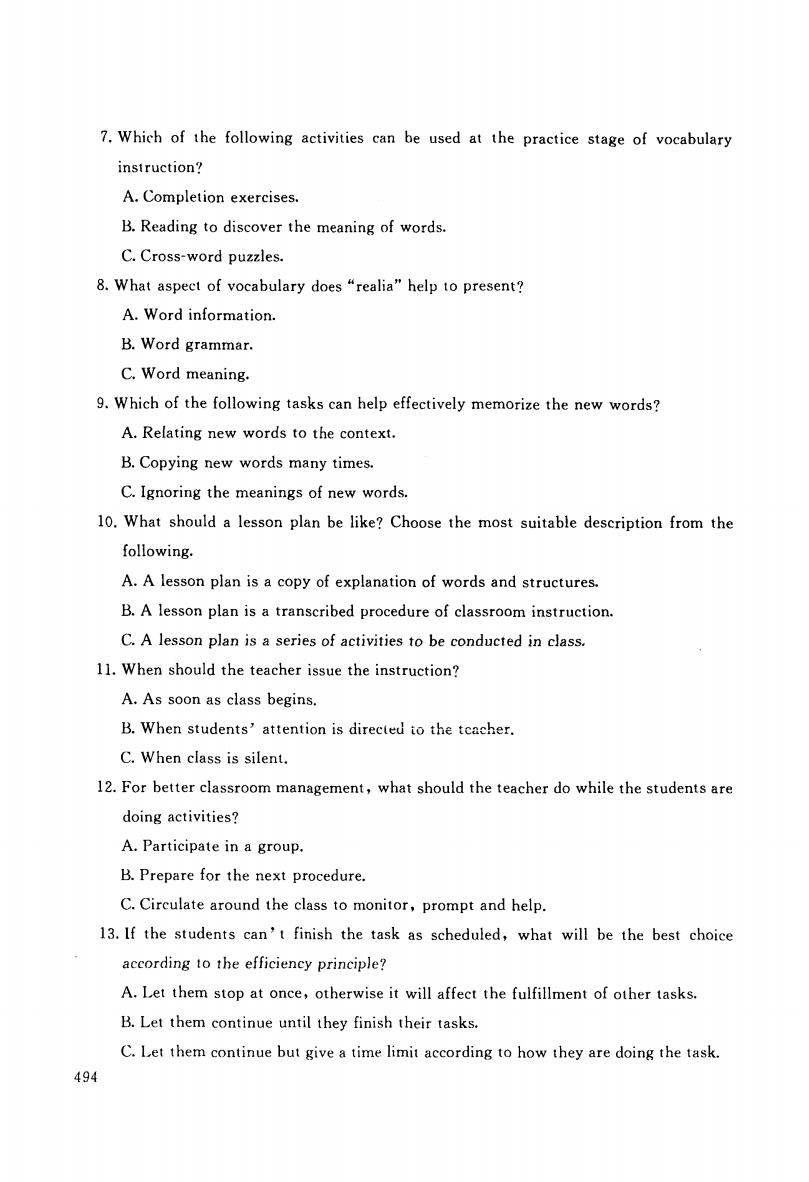
7.Which of the following activities can be used at the practice stage of vocabulary instruction? A.Completion exercises. B.Reading to discover the meaning of words. C.Cross-word puzzles. 8.What aspect of vocabulary does "realia"help to present? A.Word information. B.Word grammar. C.Word meaning. 9.Which of the following tasks can help effectively memorize the new words? A.Relating new words to the context. B.Copying new words many times. C.Ignoring the meanings of new words. 10.What should a lesson plan be like?Choose the most suitable description from the following. A.A lesson plan is a copy of explanation of words and structures. B.A lesson plan is a transcribed procedure of classroom instruction. C.A lesson plan is a series of activities to be conducted in class. 11.When should the teacher issue the instruction? A.As soon as class begins. B.When students'attention is directed io the tcacher. C.When class is silent. 12.For better classroom management,what should the teacher do while the students are doing activities? A.Participate in a group. B.Prepare for the next procedure. C.Circulate around the class to monitor,prompt and help. 13.If the students can't finish the task as scheduled,what will be the best choice according to the efficiency principle? A.Let them stop at once,otherwise it will affect the fulfillment of other tasks. B.Let them continue until they finish their tasks. C.Let them continue but give a time limit according to how they are doing the task 494
7. Which of the following activities can be used at the practice stage of vocabulary instruction? A. Completion exercises. B. Reading to discover the meaning of words. C. Cross-word puzzles. 8. What aspect of vocabulary does "realia" help to present? A. Word information. B. Word grammar. C. Word meaning. 9. Which of the following tasks can help effectively memorize the new words? A. Relating new words to the context. B. Copying new words many times. C. Ignoring the meanings of new words. 10. What should a lesson plan be like? Choose the most suitable description from the following. A. A lesson plan is a copy of explanation of words and structures. B. A lesson plan is a transcribed procedure of classroom instruction. C. A lesson plan is a series of activities to be conducted in class. 11. When should the teacher issue the instruction? A. As soon as class begins. B. When students' attention is directed to the teacher. C. When class is silent. 12. For better classroom management,what should the teacher do while the students are doing activities? A. Participate in a group. B. Prepare for the next procedure. C. Circulate around the class to monitor, prompt and help. 13. If the students can’t finish the task as scheduled,what will be the best choice according to the efficiency principle? A. Let them stop at once, otherwise it will affect the fulfillment of other tasks. B. Let them continue until they finish their tasks. C. Let them continue but give a time limit according to how they are doing the task. 494
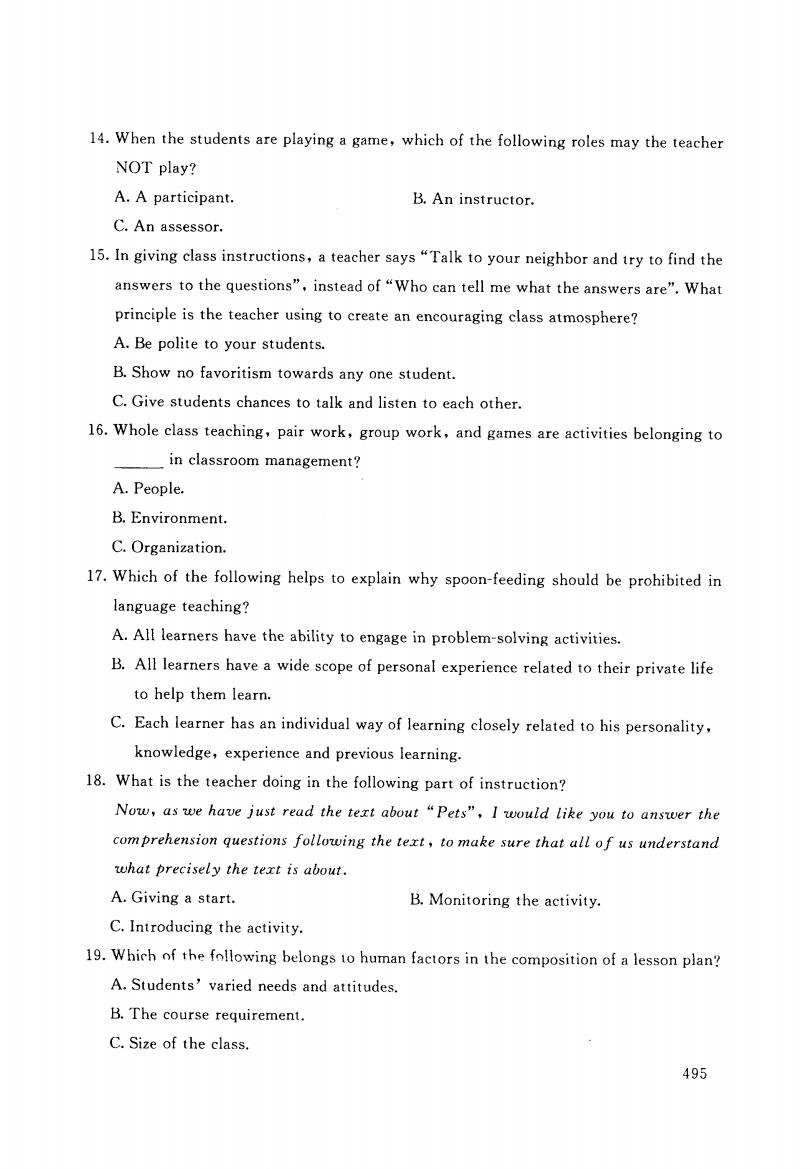
14.When the students are playing a game,which of the following roles may the teacher NOT play? A.A participant. B.An instructor. C.An assessor. 15.In giving class instructions,a teacher says "Talk to your neighbor and try to find the answers to the questions",instead of "Who can tell me what the answers are".What principle is the teacher using to create an encouraging class atmosphere? A.Be polite to your students. B.Show no favoritism towards any one student. C.Give students chances to talk and listen to each other. 16.Whole class teaching,pair work,group work,and games are activities belonging to in classroom management? A.People. B.Environment. C.Organization. 17.Which of the following helps to explain why spoon-feeding should be prohibited in language teaching? A.All learners have the ability to engage in problem-solving activities. B.All learners have a wide scope of personal experience related to their private life to help them learn. C.Each learner has an individual way of learning closely related to his personality, knowledge,experience and previous learning. 18.What is the teacher doing in the following part of instruction? Now,as we have just read the text about "Pets",I would like you to answer the comprehension questions following the text,to make sure that all of us understand what precisely the text is about. A.Giving a start. B.Monitoring the activity. C.Introducing the activity. 19.Which of the following belongs to human factors in the composition of a lesson plan? A.Students'varied needs and attitudes. B.The course requirement. C.Size of the class. 495
14. When the students are playing a game, which of the following roles may the teacher NOT play? A. A participant. B. An instructor. C. An assessor. 15. In giving class instructions, a teacher says "Talk to your neighbor and try to find the answers to the questions",instead of "Who can tell me what the answers are". What principle is the teacher using to create an encouraging class atmosphere? A. Be polite to your students. B. Show no favoritism towards any one student. C. Give students chances to talk and listen to each other. 16. Whole class teaching, pair work,group work,and games are activities belonging to _ in classroom management? A. People. B. Environment. C. Organization. 17. Which of the following helps to explain why spoon-feeding should be prohibited in language teaching? A. All learners have the ability to engage in problem-solving activities. B. All learners have a wide scope of personal experience related to their private life to help them learn. C. Each learner has an individual way of learning closely related to his personality, knowledge, experience and previous learning. 18. What is the teacher doing in the following part of instruction? Now, as we have just read the text about“Pets",I would like you to answer the comprehension questions following the text,to make sure that all of us understand what precisely the text is about. A. Giving a C. Introduci start. B. Monitoring the activity. ng the activity. 19. Which of the following belongs to human factors in the composition of a lesson plan? A.Students’varied needs and attitudes. B. The course requirement. C. Size of the class. 495

20.Which of the following is the description of "beliefs"of learners? A.They are formed against the cultural background in which the learner lives:they directly or indirectly affect learning and often form the basis of one's behavior. B.They are peculiar to different students,and closely related to personality,knowledge, experience and previous learning experiences.They directly influence the learning process and are tightly linked with the individual learner. C.Not all learners are equally good at all of them:some learners excel in speaking, others are better at writing-learners will feel confident if they can demonstrate what they are good at,while at the same time learning those skills they need most. Section II (60 points) Directions:In this section,you are presented with a picture.Read the passage and design three grammar activities.The requirement of each activity is as following: ●Presentation:present the second conditional(非真实条件句)involved in the picture in an inductive way Practice:design form-focused activity to practice the second conditional ● Application:use the second conditional item in real-life activity You may follow the table given after the passage.Make sure the three activities are related to each other Just imagine! If it rains Ill bring my umbrella If I were rich Id buy a castle 1.Is It ralning? 2.Imagine it rains.What will the womar 3.Is the man rich? do? 4.Has he got a castle? 5.Which do you think is more likely to happen? Second conditional First conditional I Were rich【of6 a castle 籍t rains I will bring my umbrella WOULD+ IF+ WILL+ 496
20. Which of the following is the description of "beliefs" of learners? A. They are formed against the cultural background in which the learner lives:they directly or indirectly affect learning and often form the basis of one’s behavior. 13. They are peculiar to different students, and closely related to personality, knowledge, experience and previous learning experiences. They directly influence the learning process and are tightly linked with the individual learner. C. Not all learners are equally good at all of them:some learners excel in speaking, others are better at writing-learners will feel confident if they can demonstrate what they are good at,while at the same time learning those skills they need m ost. Section I (60 points) Directions; In this section,you are presented with a picture. Read the passage and design three grammar activities. The requirement of each activity is as following; . Presentation; present the second conditional(非真实条件句)involved in the picture in an inductive way . Practice; design form-focused activity to practice the second conditional . Application:use the second conditional item in real-life activity You may follow the table given after the passage. Make sure the three activities are related to ,_厂‘ 可 一丫一、一~\ If it rains III 厂 - ‘,< 娜algin”!认 bring my umbrella if【were rich rd buy a castle is theman rich? I. Is It ralnlng? 2. Imagine it rains. What will the woman do? Has he got。castle? 5. Which do you think is more likely to happen? Second conditional Fir蛇 conditional 彝:撇聋rich I黝鞭鞭 。castle 囊It绷摧I鳅臻董猪my umbrella If 十 W UULD+ I「 + WILL+ 496

Activity 1 (presentation) Objectives: Classroom organization Teaching aid 1. Procedure 2. 3. Transition (how to relate to the following activity) Activity 2 (practice) Objectives: Classroom organization Teaching aid Transition how to relate to the former activity) 1. Procedure 2. 3. Transition (how to relate to the following activity) Activity 3 (application) Objectives: Classroom organization Teaching aid Transition (how to relate to the former activity) 1. Procedure 2. 3. Backup plan: 1.Predicted problems. 2.Possibie solutions. 497
Activity 1 (presentation) Objectives: Classroom organization Teaching aid Procedure 1. 2. 3. Transition(how to relate to the following activity) Activity 2 (practice) Objectives: Classroom organization Teaching aid Transition (how to relate to the former activity) Procedure 1. 2. 3. Transition(how to relate to the following activity) Activity 3 (application) Objectives: Classroom organization Teaching aid Transition (how to relate to the former activity) Procedure ·1. 2. 3. Backup plan: 1. Predicted problems. 2. I(o) , ss'ibie solutions. 497
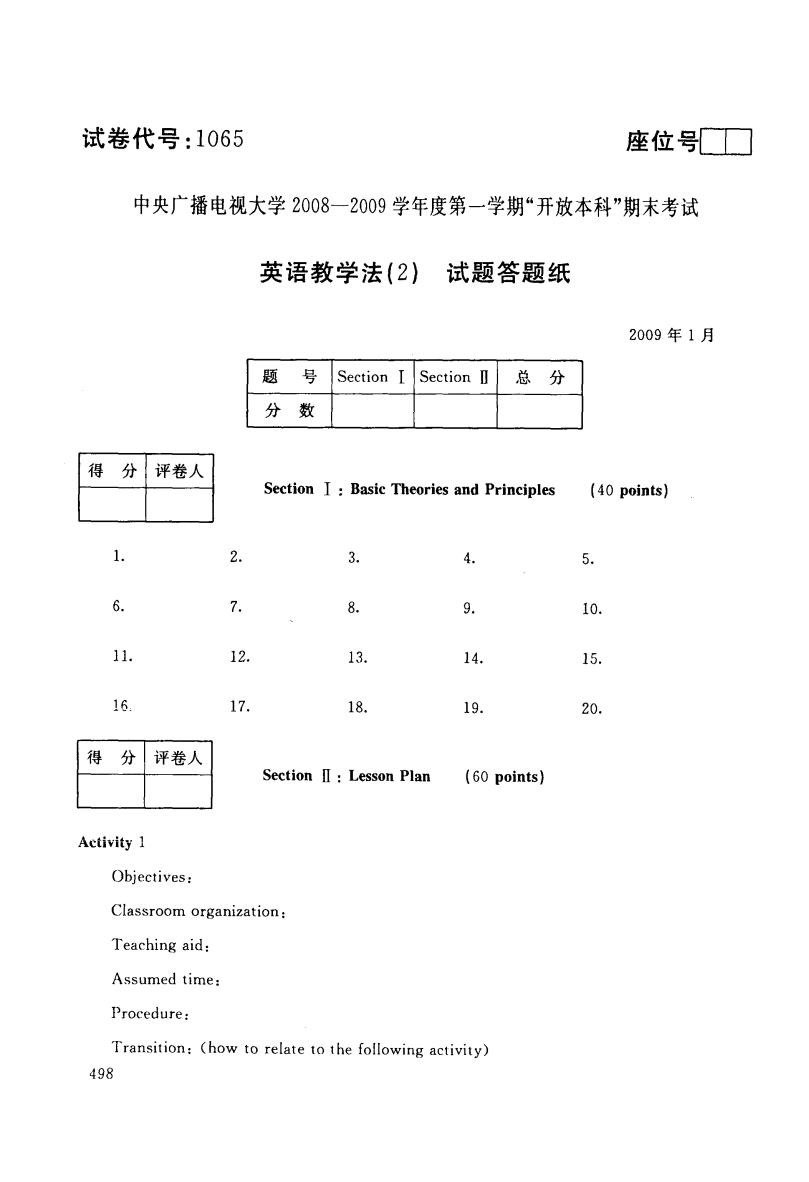
试卷代号:1065 座位■ 中央广播电视大学2008一2009学年度第一学期“开放本科”期末考试 英语教学法(2) 试题答题纸 2009年1月 题 号 Section Section DI 总 分 分 数 得分【评卷人 Section I Basic Theories and Principles (40 points) 2. 3 4. 5. 7. 8. 9. 10. 11. 12. 13. 14. 15. 16 17. 18. 19. 20. 得分评卷人 SectionⅡ:Lesson Plan (60 points) Activity 1 Objectives: Classroom organization: Teaching aid: Assumed time: Procedure: Transition:(how to relate to the following activity) 498
试卷代号:1065 座位号巨工] 中央广播电视大学2008-2009学年度第一学期“开放本科”期末考试 英语教学法(2) 试题答题纸 2009年 1月 题 号 Section j Section I] 总 分 分 数 得 分 评卷人 Section I:Basic Theories and Principles (40 points) 10 11 12 13 14 15 H 17 18 19 20 得 分 评卷人 Section I:Lesson Plan (60 points) Activity 1 Objectives: Classroom organization: Teaching aid: Assumed time: Procedure: Transition:(how to relate to the following activity) 498
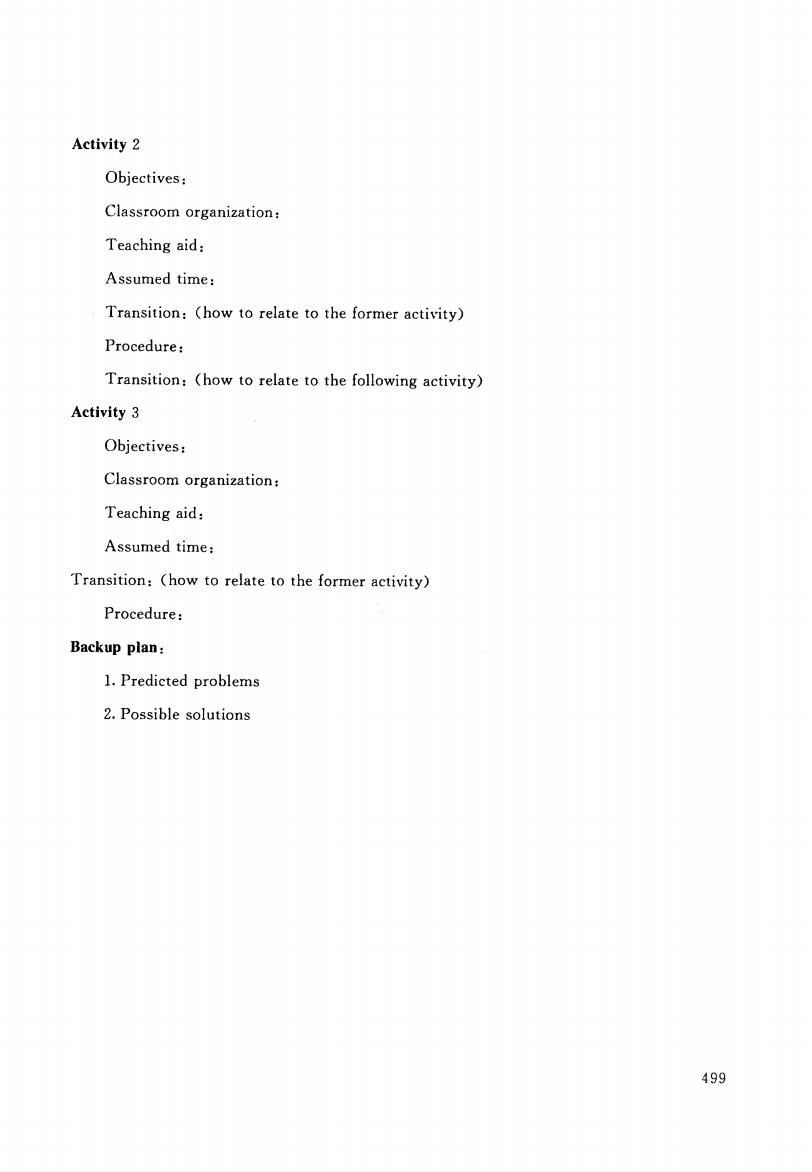
Activity 2 Objectives: Classroom organization: Teaching aid: Assumed time: Transition:(how to relate to the former activity) Procedure: Transition:(how to relate to the following activity) Activity 3 Objectives: Classroom organization: Teaching aid: Assumed time: Transition:(how to relate to the former activity) Procedure: Backup plan: 1.Predicted problems 2.Possible solutions 499
Activity 2 Objectives: Classroom organization: Teaching aid: Assumed time Transition: (how to relate to the former activity) Procedure, Transition: (how to relate to the following activity) Activity 3 Objectives‘ Classroom organization: Teaching aid: Assumed time: Transition: (how to relate to the former activity) Procedure: Backup plan: 1. Predicted problems 2. Possible solutions 499
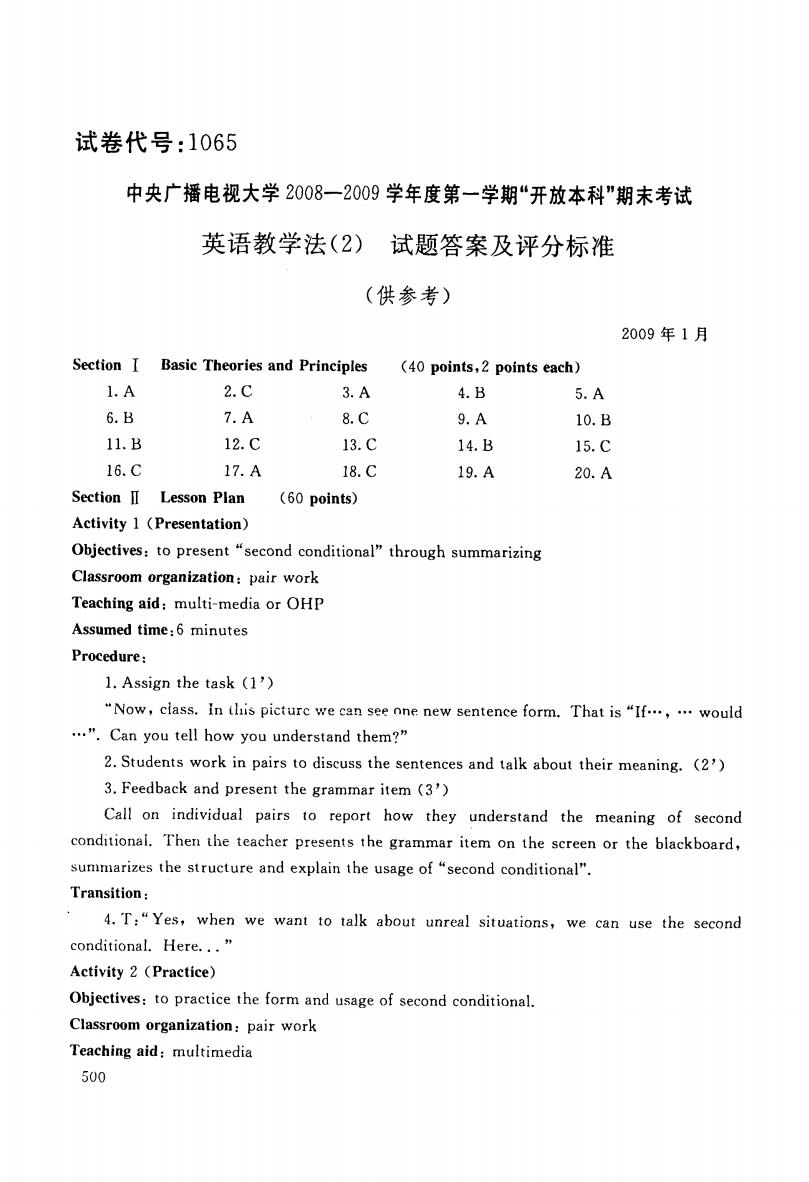
试卷代号:1065 中央广播电视大学2008一2009学年度第一学期“开放本科”期末考试 英语教学法(2)试题答案及评分标准 (供参考) 2009年1月 Section I Basic Theories and Principles (40 points,2 points each) 1.A 2.C 3.A 4.B 5.A 6.B 7.A 8.C 9.A 10.B 11.B 12.C 13.C 14.B 15.C 16.C 17.A 18.C 19.A 20.A Section II Lesson Plan (60 points) Activity 1 (Presentation) Objectives:to present "second conditional"through summarizing Classroom organization:pair work Teaching aid:multi-media or OHP Assumed time:6 minutes Procedure: 1.Assign the task (1') "Now,ciass.In ihis picturc we can see one new sentence form.That is "If...,...would ..."Can you tell how you understand them?" 2.Students work in pairs to discuss the sentences and talk about their meaning.(2') 3.Feedback and present the grammar item (3') Call on individual pairs to report how they understand the meaning of second conditional.Then the teacher presents the grammar item on the screen or the blackboard, summarizes the structure and explain the usage of "second conditional". Transition: 4.T:"Yes,when we want to talk about unreal situations,we can use the second conditional.Here..." Activity 2 (Practice) Objectives:to practice the form and usage of second conditional. Classroom organization:pair work Teaching aid:multimedia 500
试卷代号:1065 中央广播电视大学2008-2009学年度第一学期“开放本科”期末考试 英语教学法(2) 试题答案及评分标准 (供参考) 2009年 1月 Section I Basic Theories and Principles (40 points,2 points each) 1. A 2. C 3. A 4. B 5. A 6. B 7. A 8. C 9. A 10. B 11.B 12.C 13.C 14.B 15.C 16.C 17.A 18.C 19.A 20.A Section Q Lesson Plan (60 points) Activity 1 (Presentation) Objectives: to present "second conditional" through summarizing Classroom organization:pair work Teaching aid:multi-media or OHP Assumed time: 6 minutes Procedure: 1. Assign the task(1’) "Now,class. in山is picture .."e can see nne new sentence form. That is "If...,… would …”.Can you tell how you understand them?" 2. Students work in pairs to discuss the sentences and talk about their meaning. (2’) 3. Feedback and present the grammar item (3’) Call on individual pairs to report how they understand the meaning of second conditional. Then the teacher presents the grammar item on the screen or the blackboard, summarizes the structure and explain the usage of "second conditional". Transition: 4. T:“Yes, when we want to talk about unreal situations,we can use the second conditional. Here...” Activity 2 (Practice) Objectives: to practice the form and usage of second conditional. Classroom organization:pair work Teaching aid:multimedia 500

Assumed time:7 minutes Transition: 5.Assign the task (1'): (continuing 4)"Here are some pictures.Under the pictures we have some sentences which express the situation in the picture.Study the pictures and complete the sentences with“second conditional'”.It is better to work with your partner..” Procedure: 6.Pair work to practice "second conditional"(4') Students work in pairs to complete the sentences under each picture.While the students are working on the task,the teacher circulates around to monitor and to give help when needed. 7.Feedback (2') Show the pictures and sentences again on the screen and ask some pairs to give answers. Transition: 8.T:"Good.I think you did a good job.Now I want you to do something else in groups of four..” Activity 3 (Application) Objectives:to train the ability to use the second conditional to relate to students real life Classroom organization:group work Teaching aid:multimedia Assumed time:7 minutes Transition: 9.Assign the task (1') (8continued)"We know you will do a lot of things if you are rich.Make a list of things you would do with“If I were a millionaire,”1 would.” Procedure: 10.Group work (4') Students work in groups of four to talk about the things and then make a list of them. 11.Feedback (2') The teacher calls on each group to report.In order that all groups have something to contribute,he can ask each group to first give one thing and other groups give something different.When each group has had a chance,the teacher can encourage volunteers to contribute. Backup plan: Predicted problems: 1.The students may not understand the meaning of second conditional. 501
Assumed time: 7 minutes Transition: 5. Assign the task(1’): (continuing 4)“Here are some pictures. Under the pictures we have some sentences which express the situation in- the picture. Study the pictures and complete the sentences with "second conditional". It is better to work with your partner.” Procedure: 6. Pair work to practice "second conditional" (4’) Students work in pairs to complete the sentences under each picture. While the students are working on the task,the teacher circulates around to monitor and to give help when needed. 7. Feedback (2’) Show the pictures and sentences again on the screen and ask some pairs to give answers. Transition: 8. T:"Good. I think you did a good job. Now I want you to do something else in groups of four.,, Activity 3 (Application) Objectives: to train the ability to use the second conditional to relate to students real life Classroom organization:group work Teaching aid:multimedia Assumed time: 7 minutes Transition: 9. Assign the task(1’) (8continued) "We know you will do a lot of things if you are rich. Make a list of things you would do with "If I were a millionaire,”1 would…” Procedure: 10.Group work (4’) Students work in groups of four to talk about the things and then make a list of them. 11. Feedback (2’) The teacher calls on each group to report. In order that all groups have something to contribute, he can ask each group to first give one thing and other groups give something different. When each group has had a chance,the teacher can encourage volunteers to contribute. Backup plan: Predicted problems: 1. The students may not understand the meaning of second conditional. 501